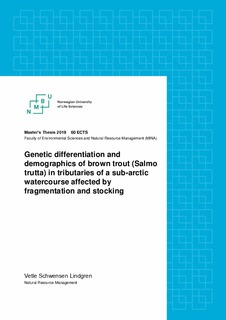| dc.description.abstract | The Pasvik river in north-eastern Norway harbours the only piscivorous brown trout (Salmo trutta) population in Finnmark County. Throughout the river, seven hydroelectric power dams were constructed between 1951 and 1978. This caused a decline in the brown trout population and the amount of spawning habitat. A stocking programme has been implemented for the last few decades and 5000 >25 cm brown trout are released into the watercourse annually. Fragmentation and stocking have led to alteration and homogenization of the genetic structure in the main river trout population. The focus in this study has been on the brown trout populations inhabiting the tributaries within the watercourse, specifically addressing if there is evidence of geneflow among tributaries and if there is geneflow between the main river and tributaries. Effects of dams and distance in the genetic structuring of brown trout in the watercourse was explored, as well as bottleneck events and the effect of admixture from stocked individuals on population densities.
Sampling by electrofishing was conducted in 10 tributaries during 2018. A total of 320 brown trout were captured. In addition, 287 samples from the main river were also used, mostly collected by anglers. Tissue for genetic analysis (MSATs) was collected from all samples, while otoliths and scales for age determination were only collected from tributary samples. Further, following the methods of Bohlin et al. (1989), data for density estimates were captured in the tributaries.
Nine out of 10 tributaries harboured brown trout, and age classes of 0+ to 3+ were present in all, meaning natural recruitment occurs every year. Genetic admixture with main river individuals in several of the tributaries strongly indicate that main river trout use these tributaries for spawning. However, some tributaries were strongly genetically differentiated from the main river and other tributaries. There was no clear evidence of the effect of barriers (hydroelectric dams) on genetic structure in the tributaries, but there were signs of isolationby-distance. Brown trout density in the tributaries decreased with the proportion of individuals admixed with the main river/stocked trout. Signs of recent bottleneck events were detected in several tributaries, mostly at the sampling station level. Lastly, the genetic diversity was found to be higher in the tributaries combined, than in the main river. | nb_NO |

